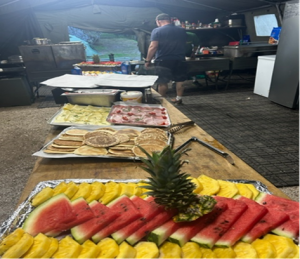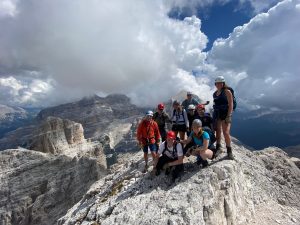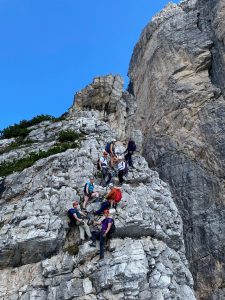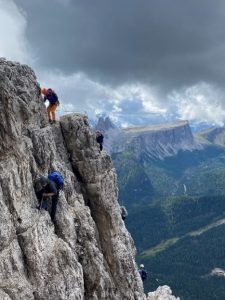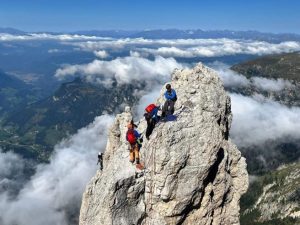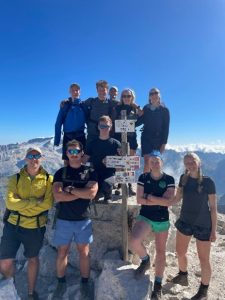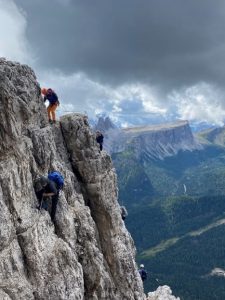I think this must have been Exeter UOTC 12th year of conducting adventure training in the Dolomites, for me my 7th with EUOTC and my 9th in total which amounts to 23 weeks in the Dolomites This is all thanks to my old mate Garry Mason who, back in 2015 as the second in command of EUOTC, kindly invited me along to assist as a summer mountaineering instructor. Now as the Unit AT Officer of EUOTC I am pleased to say I am carrying on his legacy. Garry has since retired from regular service, is now a CFAV with Dorset ACF and this year saw their first Dolomites adventure. With the assistance of EUOTC who provided chefs, instructors and Officer Cadet mentors they had an amazing time and I guess it won’t be their last Dolomites trip.
After waving Dorset ACF off, the road party and main body of EUOTC arrived at Camping Olympia which lies 5Km west of Cortina d Ampezzo. With the field kitchen already in place from the Dorset ACF exercise, all that remained to do was issue kit and erect personal tents.
The exercise is named Delago after the Delago Tower – this is the western most tower within the Vajolet towers which stands in the Catinaccio group and Comici after the famous Italian climber of Emilio Comici who made over 200 ascents in the Dolomites.
The expedition was run over 2 weeks with 4 days of travel and the aim was to deliver Rock Climbing foundation course with multi pitch proficiency and Summer Mountain foundation using Joint Services Adventure Training distributed training to 30 Officer cadets with the assistance of 9 instructors. Over the years, the exercise has evolved, grown in size and moved on from hugging a blue flame stove self-catering to a full field kitchen with chefs Alex and Michael providing amazing food.
Climbing: Cinque Tori is a favoured climbing location within the Ampezzo valley with its many easy routes suited to teaching those new to the multi-pitch climbing before venturing on to the more challenging Falzarago Tower and Lagazuoi faces. Cortina also boasts one of the best climbing walls, Cortina 360, located in Cortina d’ Ampezzo and was used to introduce students to sports climbing on one of the wet days.
After moving campsites to Canazie, and refining their technique on the indoor wall, as well as working on sport lead climbing, the climbers set off on a 3-day 2 night expedition to the world famous Vajolet Towers basing themselves at Rifugio Albert Gartle. The Vajolet Towers are on the bucket list for climbers the world over and a perfect culmination and highlight for the climbing group with all passing the muilti pitch proficiency.
The Vajolet Towers
Six Officer cadets had the good fortune to spend their trip learning multi pitch climb on a mix of trad and sport routes. With a ratio of one instructor to two officer cadets, our rope skills and confidence developed quickly. Between mountain hut coffees, to avoid the storms, our first few days were spent learning the basics of building belays, leading, seconding and abseiling.
These essential skills were put under pressure when the group headed out on their visit to the Vajolet Towers at the start of the second week. Here the climbs became more exposed and increasingly more a mental challenge and so our rope skills had to be extra slick. A personal highlight has got to be climbing the arret on the Delago tower. The drop below went on for hundreds of metres down to a cloud inversion layer that shone in the morning light. We even saw a Brocken spectre as the clouds came in below and I finished the last pitch, topping out onto the tower. This was a magnificent feeling and was shortly followed by two mega sixty metre abseils off the other side of the tower.
Whilst on our visit to the Vajolet Towers we stayed for two nights at the incredible Rifugio Re Alberto hut. The lovely people who worked here were kind, curious about our climbs and served the most delicious mountain dishes. Our half board dinner included tyrollian dumplings (either spinach, beetroot, or spec), potatoes or polenta with some kind of meat for a main, and everyone’s favourite apple strudel for dessert. The hut was full of mountain guidebooks, maps and photography books which you were able to take out on to the decking to read in the morning sun. Late afternoon, when the sun went behind the mountain the temperature dropped, you could sit in the cosy dining room and look up at the people abseiling off their last climb of the day. It was a magical place where you could really appreciate the beauty of the mountains from dawn until dusk, and is somewhere I will remember for a long time to come.
Via Ferrata
Twenty-four officer cadets tested their mettle on the various scenic via ferrata routes studded throughout the mountains. This consisted of wearing harnesses with two carabiners which clipped on to steel cables pinned into the mountain to make our ascent. We started with easier routes in order to familiarise ourselves with the equipment, footing, and general layout of the via ferrata. In the exceptionally capable hands of our instructors, we learnt quickly, and it wasn’t too long before we were trying our hand at level four or five routes. A personal favourite was Sci Club 18, a particularly challenging grade five route that offered very few resting points and even fewer footholds with which to heave yourself up. This tested my technical skills and strength immensely and also had my heart racing for five hours of gruelling climbing.
Ocdt Aiden Weymouth, intrepidly struggling to the top, exhaustedly said “I’m not sure what’s goanna give way first: my arms, my knees, or the carabiners.” However, at the end of this route, we all had an immense feeling of pride for overcoming such a difficult challenge and enjoyed a well-deserved coffee and apple strudel at the top with a view that would be hard to beat, a feeling we shared many times over during the course of the two weeks.
Our first week was spent climbing the routes around Cortina d’Ampezzo and consisted of day trips, such as Sci Club 18. In our second week we moved campsites to Canazei, a beautiful town nestled in the towering peaks of the Dolomites. It was from here that we embarked on our three day expedition. We were largely given free rein with our expedition, and undertook an afternoon of meticulous planning and organising. This helped hugely with our team cohesion, organisational, and briefing skills.
We began our expedition with the hardest route in the area, the Via Ferrata Cesare Piazzetta, which consisted largely of smooth limestone, treacherous footing, and difficult overhangs. The weather was clear and the sun was oppressive, but after many litres of water and a lot of wheezing, we completed the route and walked to the top of Piz Boe, the second highest mountain in the Dolomites. The view was breathtaking, better than anything we’d seen yet, and we settled down for the night in a cosy rifugio with sublime food. On our second day we walked, making our way down a steep descent to a café next to a sparkling lake. Our way back was less chilled out as we climbed the steep ascent back towards our second rifugio, calves burning more than our skin. Finally, on our third day, after sleeping like logs, we came down to breakfast for our final day of the trip. Having filled up to the brim on chocolate milk, we had our final, similarly beautiful day, with our last via ferrata, finishing at the top. After jubilant singing, contagious laughter, a few anxious tears, and more bumps and bruises than I could count, we had finished our two weeks in the Dolomites. There are few places whose natural beauty has roused me as much as the Dolomite mountains.
We are all extremely grateful for the generous grant and support from the Ulysses Trust with out their assistance this expedition would not go ahead
Expedition through the Gruppo Dei Cadini
After four days of increasingly difficult day trips in the Cortina area of the Italian Dolomites, eight Officer Cadets (with two instructors) from the EUOTC embarked on an ambitious two-day expedition through the Gruppo Dei Cadini, a range of peaks south of the famous towers of Tre Cima.
The trip started with a chairlift rising through the clouds above the picturesque Lake Misurina. At the top we climbed up through the Forcella de Misurina using the Via di Bonacossa. The going was tough, but the clouds sunk to give us an incredible inverted view of various peaks across the Dolomites.
A sharp drop down preceded another steep col this time the Forcella del Neve. A scenic lunch stop atop an enormous boulder in the valley below was well deserved. After lunch the Forcella del Nevaio was next which led us to the highlight of the day, the climb to the summit of Cama Cadin (2788m). The Merlone via ferrata was laden with more than 300 rungs of ladders taking us almost vertically straight to the summit.
The low clouds at the summit limited our views slightly but we could see the picturesque Refugio Fonda Savio where we would be staying that night. It was the same way back down the ladders and a short descent into the refugio where we were just in time for dinner. A delicious three course meal of vegetarian lasagne, steak and wedges and fruit salad was a great treat before an evening of playing cards under the stars. A couple of Officer Cadet’s even had room for a mammoth slice of the refugio’s signature apple strudel.
The next morning after a continental breakfast we set off down to our finish point of Refugio Auronzo. The Via di Bonacossa path led us through some spectacular passes with epic views not yet spoilt by human intervention. A lovely lunch at the refugio rounded off a rewarding expedition in the Dolomites.

